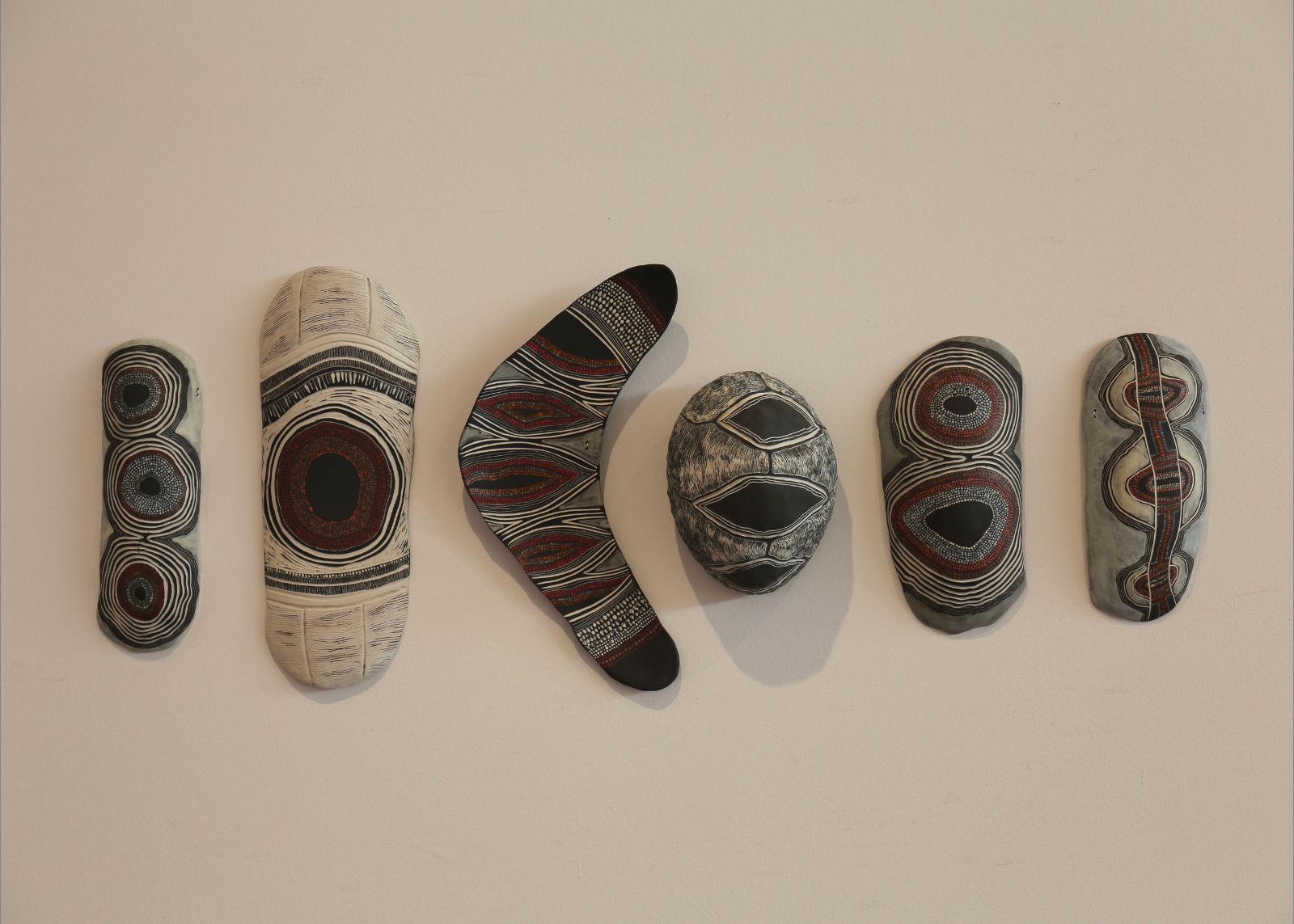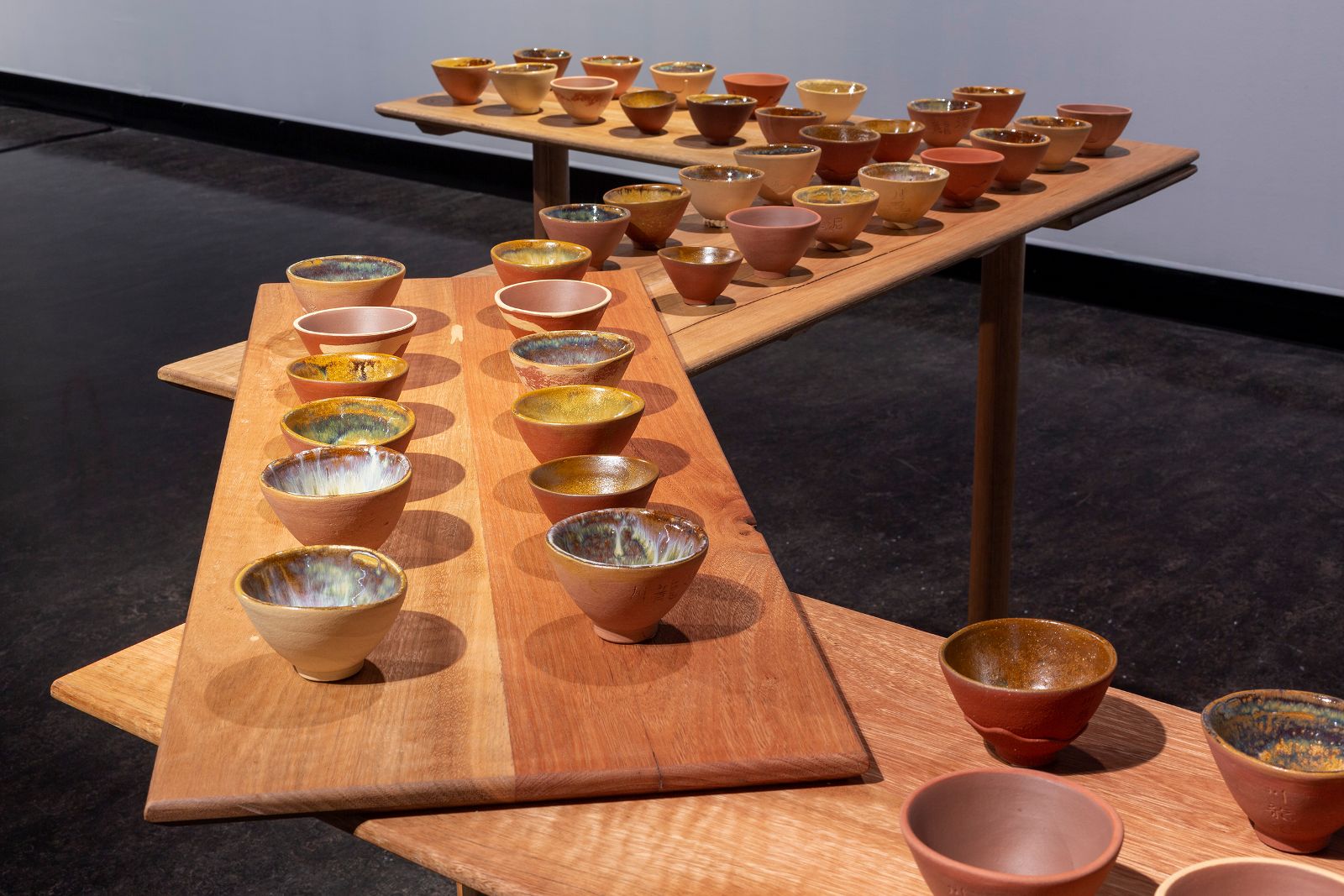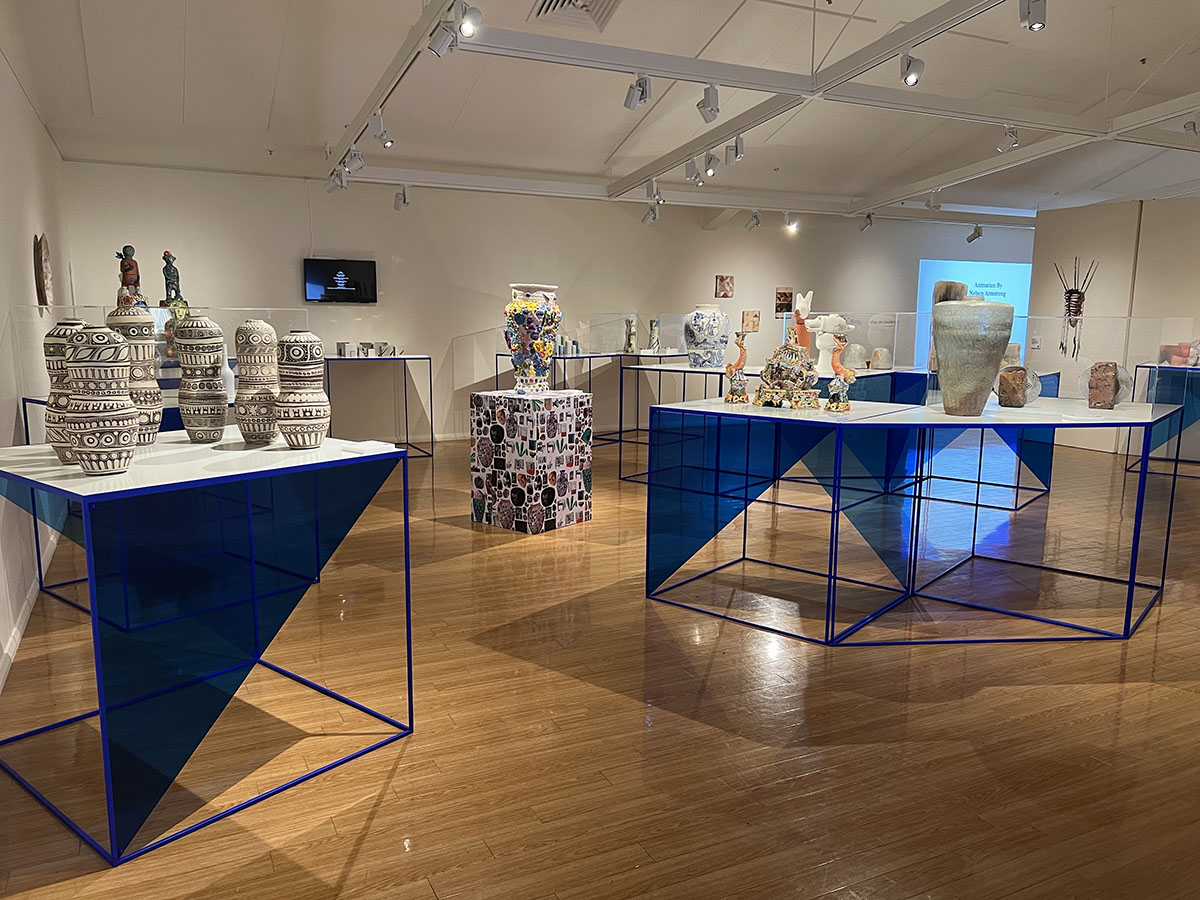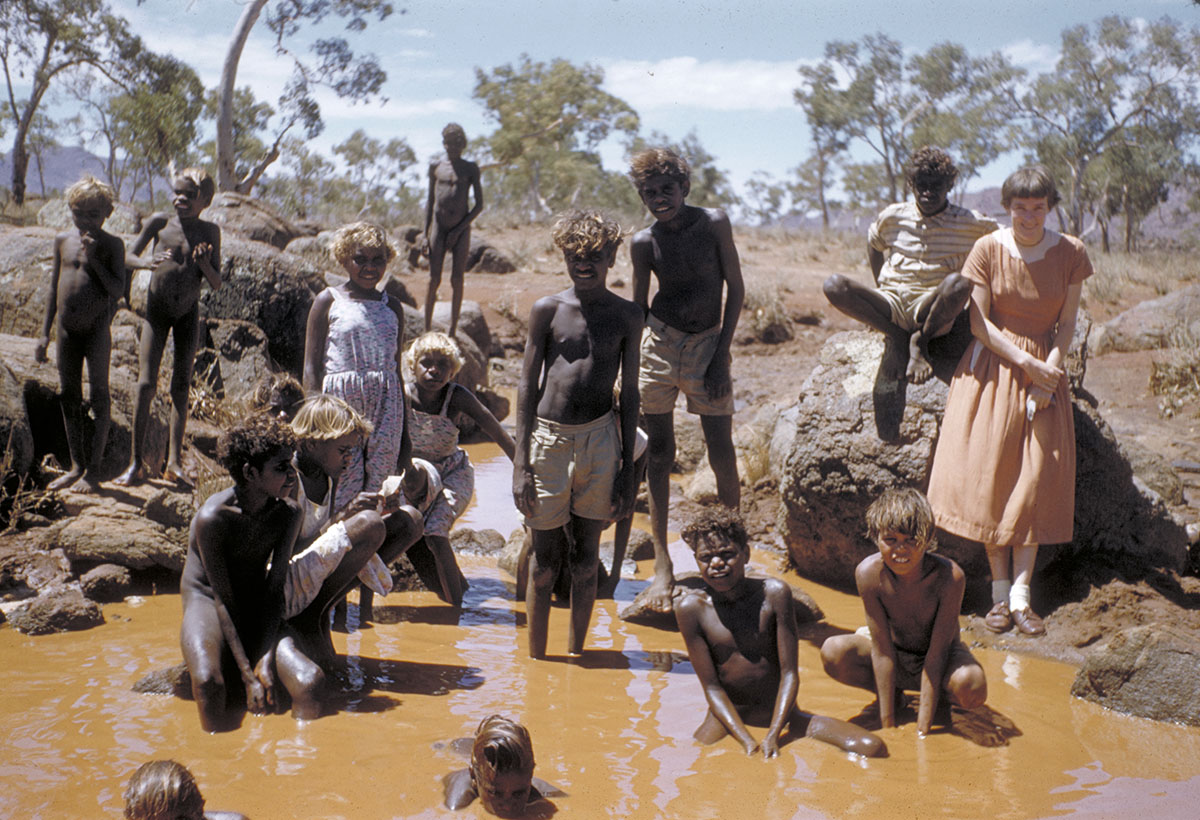In this work of intercultural co-labour, writers Tjunkaya Tapaya OAM and Hannah Kothe have responded to the 16th Australian Ceramics Triennale and a selection of exhibitions held across Mparntwe / Alice Springs. Their bilingual conversation is shaped by time, place, memory and divergent cultural traditions.
‘We developed this writing together, working across Pitjantjatjara and English, each speaking to the other in our first language.’
Firstly, Tjunkaya hand-writes pages of text in Pitjantjatjara that Hannah roughly translates, allowing her to respond to Tjunkaya and continue the dialogue. The scanned pages are then sent to Linda Rive who professionally translates the text for publication.
Each one of Tjunkaya’s pages is a vignette, a response to work she has seen that has caused her to reflect on her own history and culture. She writes from a place of knowing but purposefully doesn’t stray beyond her sphere of cultural or artistic authority. This includes an awareness of her status of visitor on Arrernte Country where the Triennale was held. Living ‘off Country’ for periods of time for medical treatment, her writing is also an expression of her longing to return home.
Tjunkaya’s written responses have been woven together with themes and ideas discussed with Hannah across their two languages. At times the writing draws on previous texts by Tjunkaya that have renewed and enduring relevance when thinking about the works presented within the Triennale.

The 16th Australian Ceramics Triennale was a coming together, as all conferences are. It provided a timely confluence of First Nations, queer and gender-diverse, cross-generational and cross-cultural communities, all voices brought together by a shared interest in the material of clay.
The event experience was described in conference sessions and in informal conversations as ‘paradigm shifting’ and ‘deeply profound’ by some non-Indigenous attendees. This manifested in moments of a palpable collision between cultural perspectives. Some non-Indigenous viewers expressed elation and revelation at a focus on Country and healing; a contrast to the tangible exhaustion of First Nations artists and curators expressing concepts tens of thousands of years old—often repeatedly—but seemingly having made impact only recently.
An almost entirely local focus, (atypical of this long-running Triennale), was necessitated by the Covid-19 pandemic. The week-long event consisted of three full days of conference presentations and demonstrations, twelve associated exhibitions and a ceramics marketplace. Held for the first time in the Northern Territory, the event drew 400 participants into what Arrernte artist Alfie Lowe described as the ‘beauty and pain of Central Australia’.[1] Clay as a vehicle of healing from trauma, eco-social concerns around the extractive nature of clay production and clay as an extension of both the body and Country resonated across the exhibitions, performances, workshops and presentations.
The conference theme Apmere Mparntwe—This place Alice Springs acted to ‘ground’ visitors from other places. Arrernte Traditional Owner and Elder Doris Stuart provided both the Acknowledgement of Country and the keynote address. Those familiar with Stuart’s decades-long activism and community leadership are aware of her insistence on providing Acknowledgments rather than a Welcome to Country. Quite plainly, she reminds non-Indigenous settlers that they aren’t and were never invited. They arrived and started tearing up the furniture. There can’t be an ongoing expectation for Aboriginal people to make them feel welcomed.
Each day of the conference centred around a theme: archetype (traditions and origins), alchemy (transformation and experimentation) and anarchy (pushing boundaries and collapsing territories). In real terms, these frameworks saw a focus on notions of clay as an embodiment of Country through presentations by Janet Fieldhouse, Maree Clarke, Penny Evans, Ben Richardson, Alfie Lowe and Yul Scarf. Panel discussions that dived into making and the material of clay as a vehicle to recover from trauma involved Virginia Leonard, Sam Gold, Simone Arnol and Bernie Singleton. Accountability, sustainability and the environment were addressed by Julie Bartholomew, Jane Bamford, Vipoo Srivilasa and Yul Scarf with the extractive nature of clay production and energy-intensive kiln firing forming troubling questions.
.jpeg)
Of the twelve exhibitions presented in venues across the town of approximately 30,000 people, four created resounding impressions to which Tjunkaya drew inspiration to reflect on her own practice, history and culture.
In earth: Country–from the ground to the sky at Tangentyere Artists Gallery, Gunditjmara and Torres Strait Islander curator Lisa Waup brought together fourteen women artists, spanning First Nations ceramics practice nationally. Matrilineal knowledge transmission forms a core component of the exhibition, with two mother/daughter pairings and one aunt and niece exhibiting within the broader context of generational exchange: works by Ernabella artists Carlene and Marissa Thompson alongside Peggy and Jan Griffiths from Waringarri Arts on Miriwoong Country, and Nanette Shaw and Fiona Hughes of Trowunna (Lutruwita / Tasmania). Penny Evans’ set of carved stoneware wall pieces depict sacred sites on Country and her matrilineal line, while Naomi Hobson’s four terracotta poles refer to the Wiimu or red ant travelling story which speaks to kinship connections across Country.
Considering Aboriginal practices of cultural transmission among women, Tapaya recalls her childhood spent with family and the knowledge of Country shared with her through instruction, observation and cultural practice:
Panya ngunytjulu kamilu tjanaya mai kunakanti atulpai apungka kala nyakupai. Munuya pulkara kilinankupai unytjuntju munuya mai uninypalta uralpai. Palula nguruya rungkalpailta tjiwangka tjungaringka. Ngayulu nintiringangi ngayuku ngunytjungka munu anangu kutjupa tjuta-ngka kulu. Nyara palula nguru ngayulu pulkaringkula workaringi craft roommangka artist. Ngayulu nintini ngayaku untalpa panya walka ngayuku munu Tjukurpa kulu. Kuwari ngayulu nintini puliri tjuta.
I recall my mother and my grandmother, and all the women would be there pounding kunakanti (a native grass) with their stone tools, and we would watch them at work. They would clean and process them until all the chaff was gone, and all they had was clean seed left. Then they would grind them up with their tjiwa and tjungari grindstones. I spent my childhood and adolescence learning in this way from my parents and other relations and once I was old enough, I joined the craft room and became an artist. I shared my skills and knowledge with my [late] daughter and now I pass them on to the next generation, my granddaughters.
Some works in earth: Country thicken and extend the line between clay and other material practices, incorporating shell, kelp, commercial ghost nets, bones, charcoal, ochre, tree sap and grass resin. Nanette Shaw and Fiona Hughes use clay as a means to continue their reclamation of Tasmanian women’s shell stringing and kelp basket making traditions. Working in clay for the first time, the artists transpose traditionally collected shells and kelp into ceramic objects. Exhibited alongside their kelp and shell counterparts, the ceramic objects aren’t immediately discernible as objects of clay, demonstrating the seamless connection between traditional and contemporary cultural practices. The three works featured by Cassie Leatham are potent representations of culture, depicting shell middens, birthing practices of ‘Grandmother trees’ and beliefs around the transition of the spirit and soul following earthly death.
Strong support for and allyship with First Nations matriarchs was demonstrated by queer, gender diverse and non-binary communities across the conference—and the wider community—and through the all-female team of conference organisers. A group of emerging ceramic artists, working out of the local Bath St studios, initiated and organised a fundraising exhibition in support of the local First Nations group, The Strong Grandmothers. Mugs on Mugs invited artists to contribute a ceramic mug featuring a face or portrait, human or otherwise. The fundraiser was one of the most popular events held during the week. It represented a welcome and necessary ‘giving back’ to First Nations communities, whose emotional labour buttressed the entire series of events.

Drawn by stones is a touring show originating at 4A Gallery, Sydney, presented at Watch This Space, a long-running Mparntwe artist run initiative. Curated by Bridie Moran with assistant curators and artists Jody Rallah and Annette An-Jen Liu, Drawn by stones presents works by artists from Australia, Hong Kong and Taiwan that interrogate ‘nationhood’, Indigenous sovereignty and contested histories. The exhibition takes its title from Marvin Bell’s 1984 poem Drawn by Stones, by Earth, by Things That Have Been in the Fire.
For Tapaya, this storytelling across cultural and national boundaries and a focus on the universality of materials prompted her to revisit the history of intercultural skills sharing and exchange at Ernabella Arts:
Kaya kungkawaṟa mankurpa iyaṉu tjana ankula batik-iku nintiringangi. Intanitjala uṟungka munkara kungkawaṟa ini nyanganpa Yipatinya munu Nyukananya munu Jilliyannga. Nyanga paluṟu tjanaya warka nyangaku nintiringangi munuya maḻaku pitjala nganaṉanya nintiningi work nyanga batik-iku kala nintiringkula wiṟu tjuṯa palyara iyalpai gallery tjuṯa-kutu.
Many years ago, three of our younger women were sent on a journey to learn about batik. They went overseas, to Indonesia, and their names were Yipati, Nyukana and Jillian [Yipati Kuyata Williamson, Nyukana Daisy Baker, Jillian Rupert]. There, they watched and learned a great deal about batik, and when they returned home, they passed on their knowledge to us, and we in turn, learned how to produce beautiful batiks, many which have ended up in galleries and exhibitions.
Working within the expanded field of ceramics, Drawn by stones relies heavily on the idea that the foundations of ceramic practice lie in the earth. As Jody Rallah describes, ‘clay is an extension of Country just as I am an extension of Country.’[2] A similar link can be drawn with the 70 years of practice of the artists at Ernabella, across sand drawing, batik, painting, weaving and contemporary ceramics. All six exhibitors expose and explore clay as a universal material used across cultures, including in the machine of European colonialism. Dean Cross and Jody Rallah both use clays, ochres and charcoals collected on Country to present delicate reflections on the relationship between land, the body, memory and history. Penny Evans presents a specially commissioned custom wallpaper work with text. A river of English words used to describe the form of clay are arranged on a large white draped scroll-like paper in a roughly hexagonal/diamond shape, referencing southeast Aboriginal iconography. Ray Chan See Kwong also references the shape and movements of rivers. Using local Chuen Len (Hong Kong) clays, Chan has created 49 teacups arranged in the of form of a river. These humble everyday items were produced through a 2018 public art and community project and due to the enduring nature of ceramic production, will form part of archaeological memory.
Clay on Country, an exhibition of Central Australian ceramics, locally developed by Artback NT (for touring), triggered Tapaya’s reflection on cultural authority and the use of manta (clay/earth) in art making. Two large stoneware vessels by Tapaya are included, both representing the Kungkarangkalpa or Seven Sisters tjukurpa. On visiting Clay on Country, Tapaya provided this response:
Ngayuku warka, ngayuku culture. Ngayuku Tjukurpa nyanga palula ngaranyi kuwari. Kana palula nguru kampatjangka tjunkupai munu ngayulu palyalpai basketa, mununa beanie kulu palyalpai, ngayuku Tjukurpa. Palu ngayulu putu Tjukurpa ngura kutjupitja tjuta putu palyalpai. Palu ngayulu Kungkarangkalpa Tjukurpa kulilpai, panya ngura Atilala ma pitjangu Cave Hillta kutu mununa palyalpai.
My work is my culture. My tjukurpa (ancestral Dreaming) features in most of my works. I could never depict someone else’s Country, and I could never present someone else’s tjukurpa. But I can depict my own Kungkarangkalpa (Seven Sisters) tjukurpa, which goes from Atila (very close to my birthplace) to Cave Hill.
Panya ngayulu ceramic-ngka walkatjunkupai munuṉa piṟuku canvas-tjangka kuḻu palyalpai.
I often inscribed this story onto my ceramics [in language] and also mark into the surface of the clay designs that represent these stories. I also tell these stories with paint on canvas.
Panya nganaṉa manta nguṟu palyalpai manta panya tjintjiṟa-nguṟu. Mantjiṟa ceramic palyalpai. Ka manta paluṟu kuṉpu puḻka piti wiṟu palyalpai. Kala piti tjuṯa palyaṟa nintiringkupai.
I have an affinity with clay from the earth, especially sometimes clays (terra sigillata) that have come from places like claypans [Tapaya’s Country includes significant claypan sites]. Using this material from the earth I create works of art, objects of culture and beauty. It is enduring and robust, and it can be used on beautiful bowls and vessels. We have learned how to create many kinds of forms, some reference our traditional vessels and cultural sites.
Curated with a wide focus on place and materials, Clay on Country features over fifty artists, both First Nations and non-Indigenous, living on local Arrernte Country as well as adjacent Pitjantjatjara and Ngaanyatjara, Western Arrernte and Warumungu Lands. A community and cultural development project as much as a regional survey, established career ceramic artists are shown beside students studying ceramics at Charles Darwin University and Batchelor Institute of Indigenous Tertiary Education, and art centre artists working in clay for the first time. Premised on connection to Country expressed through clay as the material of Country, the exhibition draws into dialogue pastoralist legacies, environmentalist concerns over fracking and mining and First Nations knowledge systems.

The twenty-two artists in SIXTY: The Journal of Australian Ceramics 60th Anniversary 1962–2022 represent those working at the highest level in contemporary Australian ceramics and arguably, some of the most technically and conceptually polished works across the Triennale. Curated by Lisa Cahill of the Australian Design Centre and Anna Grigson of Sabbia Gallery, it also represents many artists associated with the Journal of Australian Ceramics over its impressive 60-year history.
Glenn Barkley’s highly saturated trophy-like mosaic vessel draws viewers into the space creating a welcome aesthetic disruption and sense of play among some highly refined and more serious pieces. As Barkley explains:
If history tell us anything it’s that in life and art there is only a razor thin difference between the op shop, the skip and the museum and I want my work to conceptually co-exist in those three places, and where art can be found if you know how to look.[3]
Ernabella artist Alison Milyika Carroll is also featured in SIXTY, her seven-piece work telling the Kungkarangkalpa or seven sisters tjukurpa, to which Tapaya is also a custodian. While representative of different elements of the same story, the centrality of the narrative across both artists’ work is indicative of the foundational status Kungkarangkalpa holds in the lives of Aboriginal women across the vast desert regions of inland Australia.
For Tapaya, the show provoked a response relating to exhibitions as historical documentation of changing institutions over time. Technical experimentation and exploration are well documented among the pages of the Journal of Australian Ceramics, just as they form the bedrock of the development of Ernabella Arts.

Kuwariṉa Ernabella-ku tjukurpa irititja walkatjunanyi nganaṉala tjitji kuḻunypa tjuṯa nyinangi iriti mulapa. Ka craftroom kuwaritja wirkanu (1948-pangka) kaya kungkawaṟa tjuṯa pitjala tjataṟira warkaringi.
I’ve been thinking about the history of the Ernabella craft room, from the time when we were little children living there, a long time ago. The current craft room started up then (around 1948) when teenaged girls and young women began going there regularly to work.
Ka nyanga palula-nguṟu wiṟu tjuṯa pakaṉu ka craftroom ngangampa iriti-nguṟu pakaṟa wiṟu tjuṯatjara kuwari ngaṟanyi. If was from these early beginnings that our original craft room grew into a place of exciting experimentation in new media over the coming years to become the place it is today.
Kaṉa tjukurpa irititja nyangatja tjunanyi nyura nyakula nintiringkula kulintjaku panya. Ngayulu tjukurpa irititjaku nintingku walkatjunu.
I invite you to consider this history. I’ve lived through vast changes and write (and make) work from a place of lived experience.
Clay on Country and SIXTY: The Journal of Australian Ceramics 60th Anniversary 1962–2022 are installed in a joint space at the Araluen Arts Centre with a false wall separating them. The juxtaposition of these exhibitions ‘back to back’, one markedly local and firmly grounded, and the other expansive, reaching across place and the breadth of technical practice, neatly manifest the wider tensions, questions and collisions at play across the Triennale as a whole.
Grounded in place and focused on First Nations perspectives, the 16th Australian Ceramics Triennale was at times at uncomfortable, perhaps necessarily so. Diverse artists, makers, curators and collectors were bought together by a shared interest in clay and ceramic practice, the ancient art of turning mud and water into lasting representations of culture—messy and transformative work.
Burdened with the emotional heavy lifting, First Nations exhibitors and presenters were in large part the generous givers of precious knowledge, non-Indigenous audiences the eager beneficiaries. This imbalance forces a reconsideration of the Pitjantjatjara concept of ngapartji-ngapartji, meaning reciprocity or fair exchange, and whether in this context an equal and meaningful exchange occurred, particularly for those First Nations artists living and working on Arrernte Country and surrounding communities.
Revisiting the claims of ‘shifting paradigms’, it seems there is much work still to do. The Triennale and the ceramics community are part of a dialogue that while it has been slowly building at a national level now seems to be informing all creative practices with a sense of urgency. Beyond the efforts of a single institution or organisation, real transformation requires non-Indigenous people at all societal levels to start carrying the greater load.
Tapaya has used her artistic practice over more than five decades to document and maintain strongly held cultural knowledge. This generous contribution to the Australian cultural landscape has also helped her navigate periods of enormous change. Through her experiences, Tapaya represents a generation of Aboriginal women artists whose strength, endurance and teaching/sharing is yet to be fully appreciated and valued.
Palula nguru ngayulu warka nyaratja putu wantinyi. Iriti nguru alatjituna nintiringu. Munula kuwari wiru tjuta palyalpai. Ngayulu wantintja wiya. Ngayulu pulkara mukuringanyi wiru tjuta palyara pukularinytjikitja.
My artistic practice has been a life-long passion that I have never been tempted to put down. I have pursued a 50-year career in the arts. I have created hundreds of works in my time in a variety of medium. I could never stop being an artist now. It is what I am. I feel I have an unstoppable creative force, a compulsion to make, to represent the beauty and the story I see in my world around me.
Uwa palya ka nyuntu rita-milaṟa kulinma tjukurpa irititja uwa palya. Ngayulu ini. Tjunkaya Tapayanya. Uwa palya alatjiṯu.
I hope what has been shared with you through these stories has been worthwhile. My name is Tjunkaya Tapaya. That’s all there is to say.
Footnotes
- ^ Alfie Lowe, from ‘Place Makers’ panel discussion on Wednesday 20 July 2022 at the Australian Ceramics Triennale, Mparntwe (Alice Springs).
- ^ Jody Rallah, online panel discussion, 1 September 2021, UNSW Art & Design and 4A present Clay Foundations: Can ceramics explore a national identity? https://www.youtube.com/watch?v=eV_jNtlrWac accessed 27 July 2022.
- ^ Glenn Barkley, artist statement SIXTY: The Journal of Australian Ceramics 60th Anniversary 1962–2022, Australian Design Centre, 2022.See https://australiandesigncentre.com/sixty/glenn-barkley/
